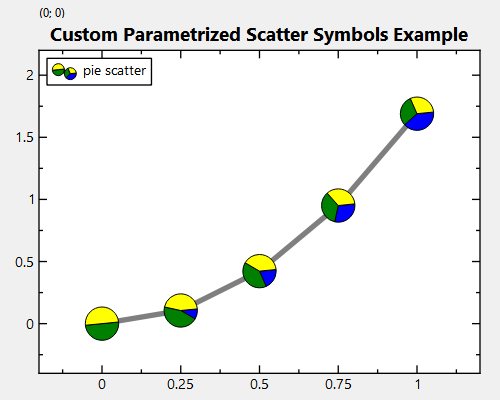NEW/BREAKING: refactor CMake-Code, so static/dynamic switch is done via <code>BUILD_SHARED_LIBS</code>, which retires <code>JKQtPlotter_BUILD_STATIC_LIBS</code>, <code>JKQtPlotter_BUILD_SHARED_LIBS</code> and removes the capability to build static and shared libraries in one location (fixes issue #104) NEW: prepareed library for CMake's <a href="https://cmake.org/cmake/help/latest/module/FetchContent.html">FetchContent</a>-API NEW: the different sub-libraries JKQTPlotter, JKQTFastPlotter (DEPRECATED), JKQTMath, JKQTMathText can be activated/deactivated with CMake options JKQtPlotter_BUILD_LIB_JKQTPLOTTER, JKQtPlotter_BUILD_LIB_JKQTFASTPLOTTER, JKQtPlotter_BUILD_LIB_JKQTMATHTEXT, JKQtPlotter_BUILD_LIB_JKQTMATH |
||
|---|---|---|
| .. | ||
| CMakeLists.txt | ||
| paramscatterplot_customsymbol.cpp | ||
| README.md | ||
Example (JKQTPlotter): Parametrized Scatter-graph with custom symbols
This project (see ./examples/paramscatterplot_customsymbol/) demonstrates using JKQTPlotter to draw a parametrized scatter graph (JKQTPXYParametrizedScatterGraph) with custom symbols. To demonstrate this, we create a plot with several symbols, connected by a line, where each symbol shows a pie-chart with varying fractions.
The source code of the example can be found in paramscatterplot_customsymbol.cpp.
First we create a plotter window and get a pointer to the internal datastore (for convenience). Then we add three new datacolumns and obtain back inserters.
JKQTPlotter plot;
JKQTPDatastore* ds=plot.getDatastore();
size_t columnX=ds->addColumn("x");
auto colXInserter=ds->backInserter(columnX);
size_t columnY=ds->addColumn("y");
auto colYInserter=ds->backInserter(columnY);
size_t columnS=ds->addColumn("sym");
auto colSInserter=ds->backInserter(columnS);
Now we define a functor that draws a pie chart with three segments with fractions f1 (blue), f2 (green) and 1.0-f1-f2 (yellow):
auto pieFunc=[](QPainter& p, double f1, double f2) {
double f3=1.0-f1-f2;
QRectF rec(-0.5,-0.5,1,1);
p.setPen(QPen(QColor("black"), p.pen().width(), Qt::SolidLine));
p.setBrush(QBrush(QColor("blue")));
p.drawPie(rec, 90, -f1*360*16);
p.setBrush(QBrush(QColor("green")));
p.drawPie(rec, 90-f1*360*16, -f2*360*16);
p.setBrush(QBrush(QColor("yellow")));
p.drawPie(rec, 90-(f1+f2)*360*16, -f3*360*16);
};
Now we create data for the plot, x and y follow a simple function and the symbols are encoded in a separated column, where for each datapoint, we register a new symbol using JKQTPRegisterCustomGraphSymbol(), which is drawn by a differently parametrized (f1,f2) functor pieFunc.
const int Ndata=5;
for (int i=0; i<Ndata; i++) {
// put data
const double x=double(i)/double(Ndata-1);
*(colXInserter++)=x;
*(colYInserter++)=pow(x*1.3, 2.0);
*(colSInserter++)=JKQTPRegisterCustomGraphSymbol(std::bind(pieFunc, std::placeholders::_1, x*0.4, 0.5-x*0.2));
}
Finally we create a graph in the plot, which displays our datasets:
JKQTPXYParametrizedScatterGraph* graph1=new JKQTPXYParametrizedScatterGraph(&plot);
graph1->setXColumn(columnX);
graph1->setYColumn(columnY);
graph1->setSymbolSize(25);
graph1->setDrawLine(true);
graph1->setLineWidth(4);
graph1->setDrawLineInForeground(false);
graph1->setColor(QColor("black"));
graph1->setTitle(QObject::tr("pie scatter"));
The symbol type is stored in columnS, note however how we have to give a custom JKQTPXYParametrizedScatterGraph::symbolColumnFunctor, because the default one maps the values in the column to the range [0...JKQTPMaxSymbolID] in a cycling fashion (using a mod operation), but here we want to use the `stored ID directly.
graph1->setSymbolColumn(columnS);
graph1->setSymbolColumnFunctor(std::bind([](double /*x*/, double /*y*/, double symbolcolumn)->JKQTPGraphSymbols {
return static_cast<JKQTPGraphSymbols>(floor(symbolcolumn));
}, std::placeholders::_1, std::placeholders::_2, std::placeholders::_3));
plot.addGraph(graph1);
The result looks like this:
